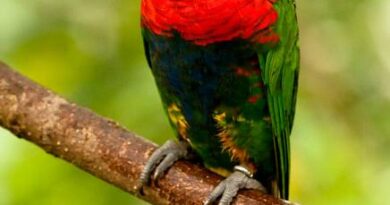Babbler
Babblers are loud birds that live in dense woodland and scrubland. The bulk of them live in flocks, frequently in the mixed-species flocks that are so common in tropical woods. Babblers are insectivorous for the most part, though some, especially the song-babblers, supplement their diet with fruit outside of the breeding season.
Jungle-babblers are a collection of brownish species that can be separated into two ecological groupings. Pellorneum and Trichastoma species are mostly terrestrial, with short wings and tails but large legs and powerful feet. Malacopteron species are more arboreal, hence they have longer wings and tails but shorter legs. The Ethiopian and Oriental regions are home to jungle-babblers. As far east as the Philippines and Celebes, they can be found.
Although closely related, scimitar-babblers and wren-babblers have very different appearances. Long curved bills, long tails, and small legs are typical of scimitar-babblers, while short straight bills, short tails, and long legs are typical of wren-babblers, such as species of Ptilocichla and Napothera. Scimitar-babblers acrobatically hunt along branches and creepers, probing with their long bills and balancing on their long tails. Wren-babblers, on the other hand, are terrestrial, as their long legs and small tail suggest. They can be found all across the world, from the Himalayas to Australia.
The tit-babblers and tree-babblers, as represented by the genera Macronus and Stachyris, are larger and more proportionate than the previous groupings. They are mostly arboreal, as their names suggest, and they forage in an acrobatic, tit-like fashion. They are primarily found in the eastern hemisphere, from India through the Philippines, Borneo, and Java. Neomixis is made up of four species that can only be found on Madagascar.
The song-babblers are around 4–12 inches (10–30 cm) in length. Turdoides species are located in the east, in the central drier sections of Ethiopia and the Oriental regions, where they can be found in practically any type of thick scrub. The bulk of other species are found in forests, with the Oriental area accounting for the vast majority of them. The laughing-thrussel Garrulax is one of them, with the majority of them being enormous and noisy, and many of them being attractively patterned. A few sing very beautifully and are highly appreciated in China as cage birds. Some Pteruthius, Myzornis, and Leiothrix species have attractive markings, and one of them, the Red-billed Leiothrix L. hutea, is a popular cagebird known as the Pekin robin.
Previously thought to be related to starlings, rockfowl are now thought to be giant, specialised babblers. The two species are known as “baldcrows” because their heads are completely bare of feathers. The bald head of the Grey-necked rockfowl Picathartes gymnocephalus is brilliant yellow, whereas that of the White-necked rockfowl Picathartes oreas is pink.
Both species have small, rounded wings, a long tail, and long legs, and are said to hop smoothly on the ground. They reside in West African woodlands, where they can find big moss-covered stones, cliffs, and caves.
Another group of ground-babblers that is very diverse is the ground-babblers. The group consists of
Rail-babblers, Eupetes, and quail-thrushes, Cinclosoma, are two of the 20 or so species found there. Except for a rail-babbler, E. macrocercus, which inhabits in the Malaysian forests, ground-babblers are restricted to the Australasian region. Jungle-babblers, scimitar-babblers, wren-babblers, tit-babblers, tree babblers, and a few song-babblers and ground-babblers construct domed ball-like structures.
They build moss and dead leaf nests on or near the ground that are well hidden.
The majority of song-babblers construct open cup-shaped nests in low trees, bushes, and creepers, but a few ground-babblers, such as quail-thrushes, construct open cup-shaped nests on the ground. Rockfowl vary from other babblers in that they nest in small groups and make cup-shaped mud nests on cave walls or under overhangs. ORDER: Passeriformes, CLASS: Aves, FAMILY: Muscicapidae



